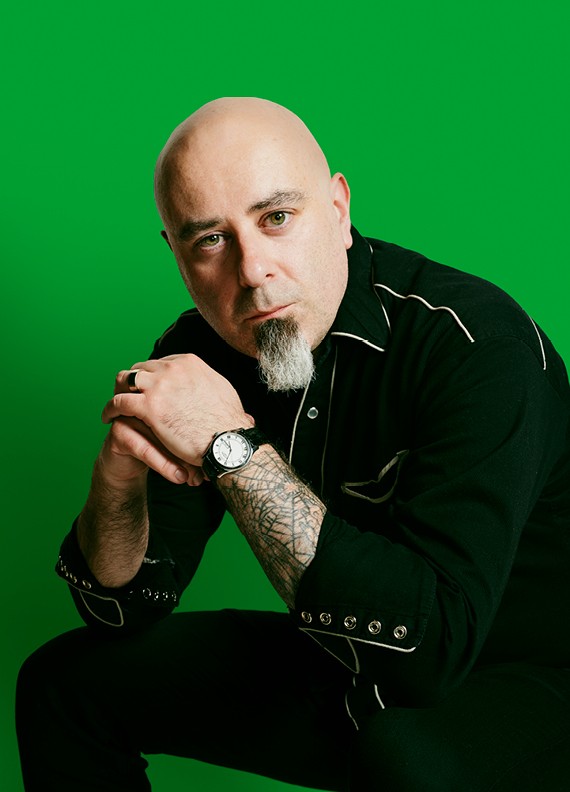Alarm Will Sound searches for the elusive essential in music of Oscar Bettison

We live in a golden age for hacks — from the professional class of people who will say anything on TV for money to the open hydrant of advice for optimizing work, diet, sleep and any other bodily function that can be put to commercial use.
Composer Oscar Bettison is not a hack. His music, though palpable, has a quality of the unknowable. In part that has to do with how little of it is available on commercial recordings (the best listening source is his website) and so it arrives still unexpected. In the main though, as Thursday night’s Composer Portraits concert at Miller Theatre showed, it’s not just because of his decidedly analog way of thinking, but also because he embraces the essential, un-hackable mystery of finding something in the imagination and working it into shape.
Alarm Will Sound, with Alan Pierson conducting, performed two major Bettison works: the New York premiere of Pale Icons of the Night, a violin concerto with Courtney Orlando as a refined, gutsy soloist; followed by the three-movement chamber symphony Livre des Sauvages. Composer and ensemble brought a strong working relationship into the concert, and that helped one hear the qualities in Bettison’s music as well as the intriguing things left to discover when, with repetition, the performances improve.
These were by no means poor or unfulfilling performances; in important ways, Alarm Will Sound had command of the music. But one also felt space between the experience of the concert and further possibilities.
Alarm Will Sound certainly captured Bettison’s sound, a kind of warm, sonic burlap of subtle microtonality and the breathing that flows through bass and woodwind instruments. It was sun-streaked Technicolor, full of grain.
The composer’s means are refreshingly simple, imaginative, and free of gimmicks. Tuning is vital because he’s working within equal temperament — one eighth of a tone sharp or flat, or imprecisely pitched percussion such as metal wrenches, when spread across the ensemble produced a timbre that planted stimulating and exotic seeds at the base of the skull. It was woody, reedy, breathy, part of the earth but also at the edge of metaphysics, ancient yet looking toward the future. In the after-intermission on-stage interview with Pierson, Bettison talked about how he looked for what he called “roughness,” which also could be called luminosity, or vitality.
At its apex in the long, enthralling cadenza in Pale Icons of the Night, this was plangent, beautiful, and human. Orlando played lines that circled around a single sustained pitch that passed seamlessly from one instrument to another, a steady-state of tone that morphed through many colors and expressive qualities, like the sun passing through the sky from horizon to horizon.
Hearing it, one recalled other modern and contemporary European composers, such as Fausto Romitelli and Olga Neuwirth, and felt strongly there is a real divide between the roughness of those composers and the decidedly more clinical, careful manner one hears as the predominant quality in American new music. Rather than an exact, digitized construction of colors and phrases, Bettison’s concerto had the kind of small imprecisions that give music life.
Part of that was the sensuous sound, the kind that can speak to the listener in an individual way. The other part was rhythm. Bettison uses shifting rhythms and meters to build a pulse, something that didn’t quite come together in stretches on Thursday. Bettison spoke about how he’s a fan of Barry White’s ’70s albums, of the “tight” sound of the bands, and on the classical side one heard the faint pentimento of Stravinsky’s way with shaping metrical form — the concerto at times seemed like the Rite of Spring, hollowed out and filled with new music.
Pierson’s technique was always sharp and precise, but there were parts of the concerto and especially the opening movement of Livre des Sauvages that sounded like the ensemble was working hard to get the rhythms right but didn’t quite feel them — Pierson noted during that interview that Bettison had notated one of the most complex rhythms he had ever seen and that it took him considerable to time break it down before he could feel it internally. One could hear such process in the playing without the effect of the pulse.
Despite that, Livre was compelling. The program notes quote Bettison as saying, “I can’t really explain what I’m trying to write,” and one heard that in the music as a fascination with something unknowable or insoluble. That’s at the core of making art music, which Bettison is doing and Miller is presenting, and hearing something one could not quite grasp, something that felt powerful but remained elusive, was a valuable reminder that there are some things that are best when left messy and mysterious.
The Composer Portraits series continues 8 p.m. March 5 with the world premiere of Dai Fujikura’s Gliding Wings (a Miller Theatre co-commission) and other Fujikura works performed by the International Contemporary Ensemble, soprano Alice Teyssier and guitarist Daniel Lippel. millertheatre.com; 212-854-7799.






